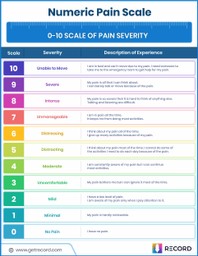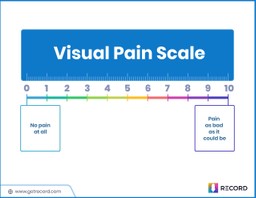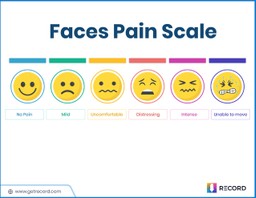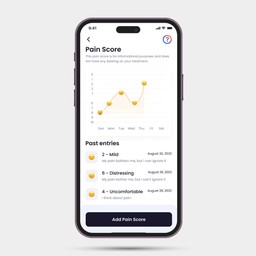Pain scores are a numerical scale. Medical professionals use them to gauge an individual’s level of discomfort. They serve as a tangible metric in the subjective realm of pain perception.
In personal injury law, accurately assessing pain is crucial. It can significantly influence the path and outcome of a case. Pain scores are used to measure a client’s suffering. They provide a basis for assessing the severity of an injury. They also help gauge its impact on the client’s quality of life.
Appropriately tracking pain scores has become an indispensable tool in the arsenal of a successful personal injury attorney.
How Pain Assessments Influence Personal Injury Cases
Pain scores are important in personal injury cases. They serve as a tangible measure of a client’s suffering. They influence both the case outcome and the calculation of damages.
Influencing Case Outcomes
Pain scores greatly impact the outcome of a personal injury case. They provide a measurable amount of a client’s pain and suffering, supporting their claim. A high pain score strengthens a client’s case, demonstrating the severity of their injury and the extent of their suffering.
Calculating Damages
Pain scores also play a role in calculating damages. Damages in personal injury cases aim to compensate the victim. They cover their pain and suffering, among other losses. Pain scores help quantify this suffering. They help determine the appropriate amount of compensation. An accurate and well-documented pain score can increase the damages awarded.
Risks of Inadequate Documentation
Poorly documented pain scores can negatively impact personal injury cases. Inconsistent or inaccurate pain scores can be problematic. The defense may use this to question the client’s credibility. They may argue that the client was not truthful about their pain levels. This can weaken the case. Therefore, accurate documentation and consistent reporting of pain scores are crucial.
Understanding Types of Pain Scales
Medical professionals use pain scores, a numerical scale, to gauge an individual’s level of discomfort. They provide a standardized method of measuring pain, allowing for more accurate and consistent assessments.
There are various types of pain scales, each designed to capture different aspects of pain. Some of the most commonly used in a personal injury case include:
Numerical Pain Scale (NPS)
The Numerical Pain Scale is the one people use most often. A person rates their pain on a scale of 0 to 10. Zero means no pain, and 10 means the worst possible pain. Healthcare providers assess these pain intensity levels either at the initial treatment or periodically afterwards.
Download the Numeric Pain Scale PDF
Visual Pain Scale (VPS)
The Visual Analog Scale, or Pain Ruler method, uses a 10-centimeter line printed on a piece of paper. Anchors at either end represent ‘no pain’ and ‘pain as bad as it could be’ or ‘the worst imaginable pain.’ The person marks a spot or ‘x’ on the line to indicate their pain intensity. A doctor then uses a ruler to measure the line and determine a pain score.
Download the Visual Pain Scale PDF
Faces Pain Scale(FPS)
The Wong-Baker FACES Pain Rating Scale is a common tool for children. It displays six faces that range from smiling to crying, representing no pain to very much pain. The person selects the face that best describes their pain.
Download the Faces Pain Scale PDF
Disclaimer: These graphics are for informational purposes only, not for medical diagnosis or treatment. Always consult a healthcare professional for medical advice. Use at your own risk.
Role of Pain Scores in Personal Injury Cases
Pain scores play a crucial role in personal injury cases by assessing the severity of an injury. They provide a clear way to measure a client’s suffering, supporting their claim and helping determine appropriate compensation. Personal injury attorneys must understand how to interpret and use these scores to effectively represent their clients and secure fair settlements.
Click here for a more detailed list of pain scale examples.
Overcoming Challenges in Utilizing Pain Scores in Personal Injury Cases
While pain scores hold great importance in personal injury cases, they also present challenges. Pain is subjective, and people have different levels of pain tolerance. Additionally, recalling previously reported numbers can be difficult.
Understanding the Subjective Nature of Pain
Pain is a subjective experience, and what may be severe pain for one person might be mild for another. This subjectivity can make it difficult to accurately assess and compare pain scores. Understanding this aspect can help attorneys better interpret and utilize pain scores in their cases.
Dealing with Variability in Pain Tolerance
Individual pain tolerance can greatly affect pain scores. Some clients may underreport their pain due to a high pain tolerance, while others may overreport due to a low tolerance. Attorneys need to consider this variability when evaluating pain scores.
Addressing Memory Issues
Clients may forget their previously reported pain scores, leading to inconsistencies in their pain history. To overcome this challenge, attorneys can encourage clients to keep a pain diary or use an app that tracks pain scores like RECORD, which can provide a more accurate and consistent record of their pain scores.
Overcoming Challenges
Despite these challenges, pain scores remain a crucial tool in personal injury cases. By understanding these issues and implementing strategies to address them, attorneys can effectively utilize pain scores to strengthen their clients’ cases.
Physician’s Perspective on Pain Assessments
The Subjectivity of Pain Scores
As a physician, interpreting pain scores can be a challenging task. Pain is inherently subjective, and the numbers reported by patients can vary significantly based on their personal pain tolerance and interpretation of the scale. A patient reporting a “seven out of 10” might mean a different level of discomfort for another patient reporting the same score. This subjectivity can make it difficult for physicians to accurately assess the severity of a patient’s pain and plan their treatment accordingly.
The Inconsistency of Pain Scores
Physicians often observe inconsistencies in the pain scores reported by patients. It’s not uncommon for a patient to report a certain number in the morning at one doctor’s office and a completely different number when visiting another doctor on the same day. This inconsistency can be attributed to various factors, including the patient’s fluctuating pain levels, their understanding of the pain assessment scale, and their comfort level with the physician.
The Imperfections of Pain Scores
Despite the challenges associated with pain scores, physicians acknowledge that they are currently the best system available for quantifying a patient’s pain. Pain scores provide a standardized method for assessing pain, allowing physicians to track a patient’s pain progression over time and adjust their treatment plan as needed. They also facilitate communication between the physician and the patient, helping the physician understand the patient’s pain experience and the patient understand their treatment plan.
The Importance of Pain Scores in Personal Injury Cases
In personal injury cases, the doctor’s assessment of the pain score is very important. It can greatly affect the outcome of the case. Physicians understand the weight their assessments hold and strive to provide the most accurate pain score possible. They know that these scores can support a client’s claim and influence the compensation awarded. Therefore, they emphasize the importance of accurate pain score reporting to their patients and encourage them to be as honest and consistent as possible in their reporting.
Practical Approach to Pain Score Reporting
Dr. Kenneth J. Hogan of Hogan Chiropractic Wellness Center in Las Vegas, Nevada, offers a practical approach to dealing with the challenges of pain scores. He shares:
Using pain scores can be an ongoing challenge. My colleagues have found a method of helping patients more accurately use the pain score system. On follow-up visits, if the patient identifies an improvement, it helps to remind them of their most recent pain score. After the reminder, reciting the option of available lower pain numbers will help them choose a lower pain score concordant with their improvement. It can also help to remind the patient of the severity of their initial presentation/pain to give reference to how far they have come.
Dr. Kenneth J. Hogan
Dr. Hogan’s insights underscore the importance of accurate pain score reporting and the role it plays in tracking a patient’s progress. His perspective provides valuable context for personal injury attorneys navigating the use of pain scores in their cases. Understanding the challenges and strategies associated with pain score usage can help attorneys more effectively represent their clients and secure fair settlements.
Overcoming the Challenges
To overcome the challenges associated with pain scores, physicians employ various strategies. They educate their patients about the pain scale and how to use it, ensuring that the patients understand what each number represents. They also encourage patients to report their pain scores regularly and consistently, helping them track their pain progression over time. In cases where patients are unable to report their pain, physicians may use behavioral assessment tools to gauge the patient’s pain level.
Understanding the physician’s perspective on pain scores is crucial for personal injury attorneys. Despite the challenges, pain scores remain an essential tool in patient care and personal injury cases. With this insight into how physicians interpret and utilize these scores, attorneys can navigate these challenges more effectively and represent their clients to the best of their ability.
Effective Strategies for Navigating Pain Scores in Personal Injury Cases
Effectively utilizing pain scores in personal injury cases requires a strategic approach. From regular monitoring to using validated pain assessment tools, there are several strategies that can enhance the accuracy and usefulness of pain scores.
- Consistent Monitoring: It’s important to regularly monitor a client’s pain. This gives a more accurate view of how their pain is changing over time. It also shows how their injury is affecting them. This can be achieved through regular check-ins with the client or by encouraging the client to keep a pain diary.
- Using Validated Pain Assessment Tools: It’s helpful to use approved and validated pain assessment tools. This makes the measurement of pain more standard. It also makes it easier to compare pain scores. Tools such as the Numeric Pain Rating Scale or the Visual Analog Scale are commonly used in medical settings and can be easily incorporated into a personal injury practice.
- Encouraging Client Participation: Encouraging clients to actively participate in their pain assessment can enhance the accuracy of pain scores. This can be achieved by educating clients about the importance of accurate pain reporting and providing them with easy-to-use tools to track their pain.
- Leveraging Technology: Technology can play a pivotal role in effectively navigating pain scores. Apps like RECORD provide an easy and convenient platform for clients to log their pain scores, ensuring a consistent and accurate record of their pain progression.
- Best Practices: Implementing these strategies can significantly enhance the effectiveness of pain scores in personal injury cases. By regularly monitoring pain scores, using validated assessment tools, encouraging client participation, and leveraging technology, attorneys can navigate the challenges of pain scores and utilize them to their full potential.
Case Study: The Importance of Consistent Pain Score Tracking
In May 2022, I experienced firsthand the importance of consistent pain score tracking in personal injury cases. I was rear-ended on the freeway while driving home from work. Like many accident victims, I was asked to rate my pain at the quick care clinic immediately after the accident. However, the chaos and shock of the situation made it difficult for me to remember what score I gave.
Later, I consulted with an attorney who referred me to a chiropractor. At the initial visit, the chiropractor asked me to rate my pain using the Numeric Rating Scale (NRS). Again, I don’t recall the exact number I reported. It wasn’t until my final appointment with the chiropractor that I was asked again about my pain score.
This presented a significant problem. I couldn’t remember my initial pain score, making it impossible for me to accurately assess whether my pain had improved or worsened over the course of my treatment. If I reported a higher pain score at the end of my treatment compared to the beginning, it could create confusion and potentially undermine my case.
This personal experience underscored the importance of consistent and accurate pain score tracking in personal injury cases. Without a clear and consistent record of pain scores throughout the treatment process, it can be challenging to demonstrate the progression of pain and the impact of the injury on the client’s life. This can potentially lead to complications in the case and may even affect the calculation of damages.
This case study serves as a powerful reminder of the need for regular monitoring of pain scores, using validated pain assessment tools, and encouraging active client participation in pain assessment. By implementing these strategies, personal injury attorneys can ensure more accurate and effective use of pain scores in their cases.
Harnessing Technology for Effective Pain Score Management
In today’s digital era, technology has become a game-changer in managing various aspects of personal injury cases, including the crucial task of tracking and managing pain scores. Innovative solutions like the RECORD app are at the forefront of this revolution, simplifying the process of pain score management.
Streamlining Pain Score Tracking with RECORD
The RECORD app is equipped with a dedicated feature for pain score tracking, allowing clients to consistently report their pain levels directly to their attorneys. This feature serves two key purposes:
- Empowering Attorneys with Real-Time Data:
Regular updates on a client’s pain score provide attorneys with valuable insights into the effectiveness of ongoing treatments. If a client’s pain score remains high or worsens over time, it could indicate that the current treatment regimen is not yielding the desired results. By monitoring these scores, attorneys can advocate more effectively for their clients, ensuring they receive the best possible care. - Educating Clients on Pain Management:
Beyond its utility for attorneys, the pain score feature also serves as an educational tool for clients. Regular logging of pain scores makes clients more aware of their pain levels and their fluctuations. This awareness can help clients understand how different activities or triggers impact their pain, enabling them to provide their healthcare providers with accurate, up-to-date information about their pain levels.
In essence, RECORD’s pain score feature is a powerful tool for both attorneys and clients, facilitating efficient tracking of progress and effective management of pain. By integrating this technology into their practice, personal injury attorneys can enhance their case management process and deliver better outcomes for their clients.
Three Alternative Methods for Pain Score Tracking
The RECORD app is a dedicated and streamlined solution for pain score tracking. However, if you need alternatives, other methods exist for digitally tracking pain scores. These alternatives might not integrate as seamlessly or easily as RECORD, but they can still be useful tools.
Digital Journals
You can use digital journaling apps to keep a daily log of pain scores. Here, clients make daily entries noting their pain levels, activities, and any triggers they notice. This method demands more manual input from the client, but it can yield a detailed record of pain progression over time.
Spreadsheets
Clients can use spreadsheets to track pain scores. They can create a simple spreadsheet with columns for the date, pain score, and any additional notes. This method enables easy visualization of pain score trends over time and sharing with attorneys or medical providers becomes straightforward.
Notes Apps
Notes apps, available on most smartphones and tablets, can also serve as a simple tool for pain score tracking. Clients can create a new note for each day or week and record their pain scores along with any relevant information.
The Value of Alternative Pain Score Tracking Methods
While these alternative methods might demand more manual input, they effectively track pain scores. Digital journals, spreadsheets, and notes apps all function as valuable pain assessment tools. They help you maintain a detailed record of pain progression and visualize pain score trends over time easily.
Sharing the necessary information with attorneys or medical providers becomes straightforward with these tools. They might not integrate as seamlessly as RECORD, but if you’re comfortable with a more hands-on approach, they make excellent options. Remember, the ultimate goal is effective pain score management, and these tools can certainly contribute to achieving that.
Using Pain Scores in Effective Case Management
Understanding and effectively navigating pain scores is a crucial aspect of personal injury cases. These scores provide a quantifiable measure of a client’s suffering and can significantly impact the outcome of a case. However, managing pain scores can be a complex task, fraught with challenges.
Leveraging technology can greatly streamline this process. Tools like the RECORD app offer a dedicated platform for pain score management, making it easier for both clients and attorneys to track and utilize these scores effectively. With features designed for easy data logging and trend visualization, RECORD is redefining pain score management in personal injury law.
We encourage you to explore the transformative potential of RECORD in your practice. Experience firsthand how RECORD can simplify pain score management and contribute to more successful case outcomes. For more information or to get started, our team is always available to assist you. Harness the power of pain scores and elevate your personal injury practice with RECORD.





